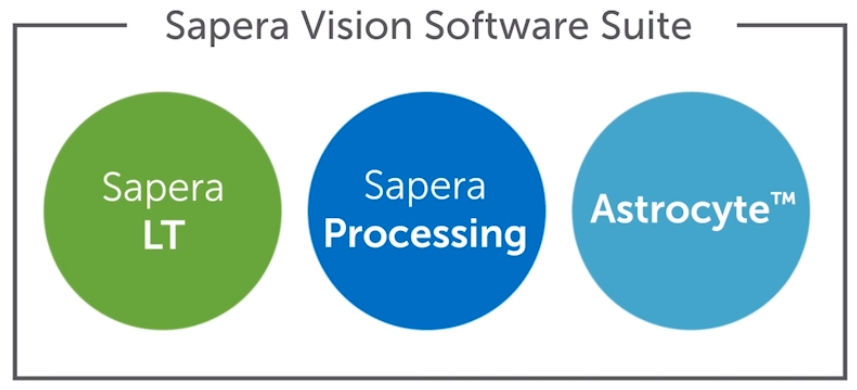|
||||||||||||||||||||||||||||||||||||||||||
|
||||||||||||||||||||||||||||||||||||||||||
Sapera Vision: Acquisition, Control, Image Processing and Artificial Intelligence (AI)
Back
to Newsletter
Go to Teledyne Dalsa Software
Go to Sapera Vision Software
Go to Sapera LT
Go to Sapera Processing
Go to Astrocyte
|
Sapera Vision Software Edition 2023-12
|
||||||||||||||||||||||||||||||||||||||||||||||||||||||
|
Sapera LT
Sapera Processing Astrocyte | ||||||||||||||||||||||||||||||||||||||||||||||||||||||
| Sapera Vision Software Edition 2023-12 | ||||||||||||||||||||||||||||||||||||||||||||||||||||||
| This software release includes both Sapera Processing 9.50 and Astrocyte 1.50 and merges functionality with Teledyne FLIR’s Spinnaker software. | ||||||||||||||||||||||||||||||||||||||||||||||||||||||
| What’s New in Sapera Processing 9.50 | ||||||||||||||||||||||||||||||||||||||||||||||||||||||
AI Inference Speed Improvement AI Rotated Object Detection AI Demos RGB Packed (24-bit) Spinnaker Other General Improvements |
||||||||||||||||||||||||||||||||||||||||||||||||||||||
| What’s New in Astrocyte 1.50 | ||||||||||||||||||||||||||||||||||||||||||||||||||||||
Rotated Object Detection
Other General Improvements SIU-032-23 |
||||||||||||||||||||||||||||||||||||||||||||||||||||||
| Rotated Object Detection | ||||||||||||||||||||||||||||||||||||||||||||||||||||||
Sapera Processing the inference class supports object detection models with and without rotation. There are new fields in the result class to access the angle and the coordinates of the rotated rectangle. A new example dataset and a new demo are available to show labelling, training and inference using rotated object detection. |
||||||||||||||||||||||||||||||||||||||||||||||||||||||
| NEW! State-of-the-art Segmentation Algorithm | ||||||||||||||||||||||||||||||||||||||||||||||||||||||
| Astrocyte introduces a new segmentation algorithm is introduced (MANet) to accompany the existing algorithm (DeepLabV3). MANet provides improved accuracy, faster training time and faster inference time. It is highly functional at finding tiny features on high resolution images. A new example dataset “Scratches” (to locate thin scratches on brushed metal plates) is available with an accompanying demo. The new algorithm is selected as default at training time (old algorithm available for compatibility). In Sapera Processing the inference code is fully compatible. | ||||||||||||||||||||||||||||||||||||||||||||||||||||||
| Inference time Improvement | ||||||||||||||||||||||||||||||||||||||||||||||||||||||
| The NVIDIA RTX 4000 series is now supported at training and inference time. See the table below for the new benchmarks below including the RTX 4090. |
||||||||||||||||||||||||||||||||||||||||||||||||||||||
|
||||||||||||||||||||||||||||||||||||||||||||||||||||||
In addition to speed improvement at inference time the training can also run faster by using multiple GPUs. When using automatic training mode, you can select all GPUs available in the system such that the training operation is parallelised across GPUs. Finally, in Sapera Vision Software Edition 2023-12, Dalsa introduces “Mixed-Precision” for quantization which uses a combination of 16-bit and 32-bit weights that allows accelerating the training time by up to 30%. |
||||||||||||||||||||||||||||||||||||||||||||||||||||||
Need a price or more application information? Please email Adept Turnkey or call our offices Adept Turnkey Pty Ltd are "The Machine Vision and Imaging Specialists" and distributor of Teledyne Dalsa products in Australia and New Zealand. To find out more about Sapera or any Teledyne Dalsa product, please call Adept Turnkey at Perth (08) 9242 5411 / Sydney (02) 9905 5551 / Melbourne (03) 9384 1775 or contact us online. |
||||||||||||||||||||||||||||||||||||||||||||||||||||||
|
If you like this page, please recommend and share it. |
|||
| More | |||




 Sapera Vision is a comprehensive solution offering image acquisition, control, image processing, image analysis, and AI capabilities. Tailored to meet the needs of applications spanning from precision metrology to pharmaceutical packaging, Sapera Software empowers users to easily design, develop, and deploy high-performance machine vision applications with ease. An easy-to-use interface, the Sapera platform provides a suite of tools that can be readily applied to a multitude of automated inspection tasks, such as
Sapera Vision is a comprehensive solution offering image acquisition, control, image processing, image analysis, and AI capabilities. Tailored to meet the needs of applications spanning from precision metrology to pharmaceutical packaging, Sapera Software empowers users to easily design, develop, and deploy high-performance machine vision applications with ease. An easy-to-use interface, the Sapera platform provides a suite of tools that can be readily applied to a multitude of automated inspection tasks, such as 